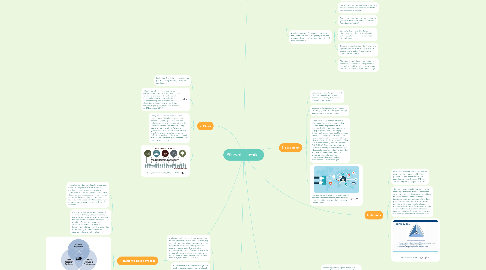
1. 3. Policy
1.1. Definition: A definite course of action put in place by authority to assure consistency.
1.2. "Health Care Policy Innovation: a new approach in a given organizational context for driving changes in the behavior of individuals, groups, or organizational entities that improve quality or reduce disparities in the delivery of health care services"(Agency for Healthcare Research and Quality, Apr 2017).
1.3. Policy is necessary to consider when making innovations in the health care system. Depending on what standing policies there are, you can determine the obstacles you will face when preparing your plan for innovation. Policies are guidelines to maintain certain order and intention. Changing policy can be very difficult depending on the scale. Ex- small business sick policy vs. government health care coverage policy.
1.4. (The Sycamore Institute, May 11, 2017)
2. 4. Evidence-Based Practice
2.1. Practicing based on proof and knowledge of methods and products used. There are multiple levels of evidence, including: Information and expert opinion, case control studies or case series reports, cohort studies, randomized control trials, and systematic reviews / meta-analysis. Systematic reviews / meta-analysis being the strongest form of evidence.
2.2. Application to Health Care: Practice of doctors and other professionals sharing evidence and experience to promote that the best treatment or form of care is provided. To me, as a health care advocate down the line, it will be important that I do thorough investigating of the validity of the modalities and recommendations that I make.
2.3. Retrieved from: https://guides.lib.unc.edu/c.php?g=498016&p=3418079
2.4. Five Steps of Evidence-Based Practice Retrieved from: https://guides.lib.unc.edu/c.php?g=498016&p=3418079:
2.5. 1. Assess - A question arises during care of a patient
2.6. 2. Ask - Completely articulate all parts of the question
2.7. 3. Acquire - Conduct a thorough focused search and select the highest quality evidence
2.8. 4. Appraise - Evaluate the evidence for validity and clinical applicability
2.9. 5. Apply - Use clinical expertise to integrate applicable evidence with attention to patient values
3. 5. Finance
3.1. It is important in the health care system that we find a more affordable and accessible way to care for patients. Costs increased when we moved from house calls to hospitals with expensive equipment. By making this equipments and forms of care (only available in hospitals) more available to doctor's offices and to patients homes, we can reduce these costs (Clayton Christensen, 2012).
3.2. Finance consists of the costs that go into the health care system. This includes all aspects of care, administration and equipment.
3.3. To me, heath care finance makes me think of my own health care expenses. Being diabetic is very expensive, I used to buy a bottle of insulin for $200 which was a one month's supply. That did not include my other insulin, along with my other 6 prescriptions. Now, I am a student and my income is low enough that I am able to get Medicaid. This allows me to get all of my prescriptions at no cost. I understand that these costs are taken from tax payers, but it seems illogical and simply impossible for me to pay for all of my prescriptions at those high costs. If there was a single-payer system, I'm sure that my prescriptions wouldn't cost nearly as much for those tax payers.
3.4. Demonstrating the high costs that we pay in the US for health care compared to other countries (Squires, D., 2015)
4. 1. Innovation Process
4.1. De Villiers Group (September 11, 2015).
4.2. Definition: The strategy used to ensure progress and development of innovation.
4.3. To me, this first pillar represents the plan of innovation with a mission in mind. Like Susan Wojcicki mentions, this includes using imagination and the collaboration of ideas to create something new (Wojcicki, Susan, July 2002).
4.4. An example of this in the health care field is when a company puts a new drug on the market. The process of putting a new drug out takes many steps that can include innovation:
4.4.1. Using ingredients that are already approved by the FDA to create something new and effective
4.4.2. Preforming Focus Group Studies to share with public opinions and get feedback
4.4.3. Collaborating with other companies to gain proper funding and recognition in order to get the drug on the market
4.5. Another example of innovation process in the health care field is diagnosing a patient with complicated symptoms with the goal of recovery in mind:
4.5.1. Primary doctor might see some symptoms and recommend to a specialty doctor to ensure proper attention
4.5.2. Primary doctor might also request test to gather as much information as possible (blood and/urine test)
4.5.3. Specialty doctor might find proper diagnoses from blood test and seeing patient. A plan of recovery now needs to be put in order.
4.5.4. Communication between the Primary and Specialty doctor is necessary to ensure proper care of patient's pre existing conditions and needs
4.5.5. Though the plan of care for a patient isn't necessarily "innovative", the process is customized and involves many opinions and circumstances in order to reach a goal
